The
Human Species
Primates
Forerunners
The ancestor of all the animals belonging to the order of which we are
members (the primates) is, probably, the Cretaceous’ mammal "Purgatorius unio", a small insectivore
animal with nocturnal habits. However, like the primitive primates, it also
included a significative quantity of fruits in its diet.
The First Primates
During the Paleocene (the most ancient epoch of the Terciary), arose the
earliest true primitive primates. One of the most ancient is the Plesiadapis,
with an appearance similar to the arboreal rodents and, as the Purgatorius, it
was simultaneously insectivore and frugivore (it ate fruit).
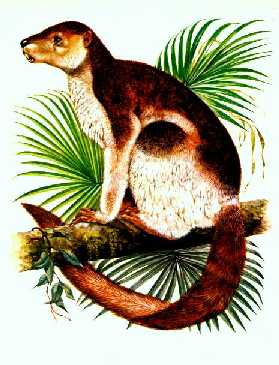
Plesiadapis (Adrian
Sington)
About 50 million years ago they were followed by the adapids, which were
also arboreal. However, they had a more modern appearance than the plesiadapis
and their diet consisted mainly on fruits and leaves. It’s thought that they
were the ancestors of the lemurs.
The most ancient fossil of the ancestor of the tarsiers’ family – The
Necrolemur – dates from a not much later epoch, compared with the adapids. It
had a big skull, more developed than the adapids’ and it was also arboreal. The
Necrolemur may also be the ancestor of the anthropoids (which include the human
species).
The Anthropoids
The anthropoids were split, 30 million years ago, between the direct
ancestors of the platyrrhines (monkeys with 36 teeth and a short visage, very
agile at the arboreal life of south-american forests) and the catarrhines
(monkeys with 32 teeth, which include the human species).
The oldest known platyrrhine is the Branisella and the oldest catarrhine
is the Ægiptopitecus, arboreal and frugivore, with a relatively developed brain
and able to distinguish between colours and reliefs. However, it still
preserved ancient characteristics like a long muzzle and large ocular orbits
far from each other.
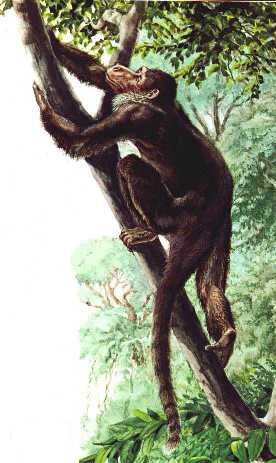
Ægiptopitecus (Günter
Radtke)
Catarrhines
Among the catarrhines two groups arose: the cercopithecoids (baboons,
colobines, other African and Asian monkeys), which preserved the tail, and the
hominoids, which lost it.
Hominoids
The group of the hominoids includes the gibbons, orangutans, gorillas,
chimpanzees, humans and several extinct species.
The gibbons were split from the lineage that originated the humans
little after the cercopithecoids had done so, or in other words, little less
than 30 million years ago. They are characterized by their long arms that give
them an unusual ability to move between the tree branches and lianas of the
forests.
The orangutans were the 2nd hominoids to be split from our lineage, 17
million years ago and, finally, the gorillas and, later, the chimpanzees also
diverged from us, between 7 and 12 million years ago. These two hominoids share
a common form of locomotion (knuckle walking) and, more remarkably in the case
of the chimpanzee, they share extraordinary resemblances with the humans
concerning to physiognomy and behaviours. They are also extraordinarily
intelligent, reaching the capabilities of a 3 or 4-year old human child.

Chimpanzee mother with
her child
Hominids
Toumaï, Millenium Man, Ardipithecus and Evolution
Trends
Until a few time ago the most ancient known hominid was Ardipithecus
ramidus, which lived 4,4 million years ago in Ethiopia. It was possibly
preceded by two species that were more recently discovered: the “Millenium Man”
or Orrorin tugenensis shall have lived 1,5 million years earlier and its bones
were found in 2000 in Kenya; Toumaï or Sahelanthropus tchadensis shall have
lived 6 to 7 million years ago and its skull was found in Chad in 2002. However,
it’s not known if those two species were ancestors of the humans, ancestors of
the chimpanzees, common ancestors or if they belonged to some parallel branch,
not directly linked to any of them. ). They would be, anyway, species very
close to the common ancestor of humans and chimpanzees. The Ardipithecus
ramidus ramidus shall have also been preceded by its relative Ardipithecus
ramidus kadabba, whose fossils were found in Ethiopia. This hominid is
posterior to Orrorin tugenensis and Sahelanthropus tchadensis, but it lived
little later, having most of the fossils ages between 5,6 and 5,8 million
years. It was a hominid with a behaviour very similar to the actual
chimpanzees’, it lived in a forest environment and it’s quite probable that it
walked upright, on 2 legs.
Concerning to Ardipithecus ramidus ramidus, there are also signs that it
was a biped (he walked upright, on 2 legs), although it may have also lived in
the forest, which doesn’t agree with the traditional idea that the bipedism developed
when our ancestors were forced to start living in an open environment (the
savanna). It’s probable that this characteristic, which provided advantage in
such environment, had been developed prior to the transformation of the forests
into savannas, to the east of the Rift Valley in Eastern Africa (where most of
the ancient hominids’ fossils have been found). It would be, anyway, a species
very close to the common ancestor of humans and chimpanzees.
A theory that has collected some acceptation inside the scientific
community and that would explain many human characteristics (the relative
absence of hair, the thick layer of visible fatness specially in babies, the
capability for controlling breathing, the water-dynamic shape of the body, among
others) is the Theory of the Aquatic Ape, according to which the first hominids
(not living in the savanna but rather in wet environments) would have crossed
through a semi-aquatic phase. During this period, the hominids would feed
themselves in shallow waters of rivers, lakes or seas, where they would have
developed those characteristics. There are some monkeys living in swamps that
walk on 2 feet in the water, allowing them to keep the head above its surface.
This seems to support this theory. It is, nevertheless, a theory still faced
sceptically by many paleo-anthropologitsts.
Along with bipedism, other properties that gradually evolved on hominids
were the dentition (eyeteeth increasingly smaller, a bigger amount of molar
teeth, parabolic distribution of the teeth), the growth of the cranial capacity
(which may have been favoured by the reduction of the volume of the jaws),
among others.
However, the evolution wasn’t so linear because it is thought, for
instance, the Australopithecus africanus was in some aspects less adapted to
bipedism than his ancestor Australopithecus afarensis.
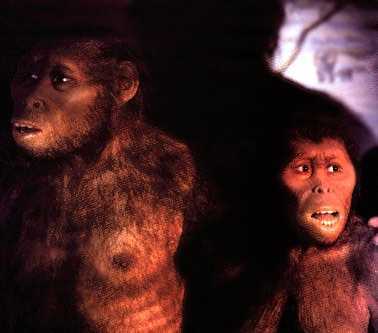
Two Australopithecus
afarensis (Richard Effland Costello)
Australopithecines
Slightly more recent than the Ardipithecus ramidus are the
Australopithecus anamensis (with an age between 4,2 and 3,9 million years) and
the already mentioned Australopithecus afarensis (with an age between 3,9 and 3
million years), whose physiognomic characteristics became gradually closer to
the modern humans’ but whose brain was kept small, with dimensions comparable
to the chimpanzees’.
The Australopithecus africanus (with an age between 2,9 and 2,4 million
years), who followed them, started to display some traces of growing brain
volume, His dentition continued to evolve to modern configurations, suggesting
a diet that was essentially composed by fruits and leaves. Because he lived in
the hot regions of Africa, it is thought that he should have a dark skin.
Contemporaneously there were 3 other species with more robust heads
faces, with similar cranial capacities – the Australopithecus æthiopicus (between
2,7 and 2,3 million years ago) and his descendants Australopithecus robustus
(between 1,9 and 1 million years ago) and Australopithecus boisei (between 2,2
and 1,2 million years ago), who didn’t leave further descendants.
Ecce
Homo
Homo habilis and Homo rudolfensis
In other branch of the evolution, the Homo habilis (between 2,2 and 1,6
million years ago) was the first species to chop tools (although there are
indirect traces that make us think that the Australopithecus africanus already did
it), instead of only use them in raw conditions, as their ancestors did and the
actual chimpanzees do. This culture is called Olduvai, which consists on the
slivering of stones so that they can display a cutting edge.
The brain volume of the Homo habilis was already considerably higher
than the chimpanzees’, which along with the slivering of tools, shows that he
would be a more intelligent hominid. It’s possible that he had elementary
speaking skills and it’s thought that he built the first shelters (stone
circles) about 2 million years ago. He would have been also one of the earliest
hominids to possess an intensely carnivore diet, which could even include
australopithecines.
A close “cousin” of the Homo habilis, the Homo rudolfensis (between 2,1
and 1,8 million years ago), was presumably the mother species of our closest
ancestors (although that is still far from being clear) and, despite the lack
of proofs, it’s thought that he was also able to sliver Olduvai tools, because
his brain volume was clearly higher than the Homo habilis’.
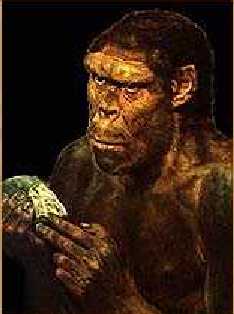
Homo habilis (Washington
State University)

Tools from the culture of
Olduvai
Homo ergaster
The Homo ergaster (between 1,8 and 1,2 million years ago), which is a
possible descendant of the Homo rudolfensis and possessed a larger brain, was
the founder of the Acheulean culture, which consisted on the slivering of
tools, in order to produce symmetric cutting edges (bifaces). These tools were
often much bigger and heavier than those produced by the culture of Olduvai.
The Homo ergaster would have become specialized in the art of hunting
and, through the use of these tools, he could transform the animal and
vegetable products. This way of life would resemble, in part, the one that
nowadays characterizes the hunting-recollecting tribes and would have forced
the individuals to join in large social groups. It would have also encouraged
the development of the communication and of the vocal and body language (in
order to coordinate their hunting tactics and transmit knowledge about the
surrounding environment, for instance).
Homo erectus
The Homo erectus (who lived between 1,2 million and 150 thousand years
ago) probably descended from the Homo ergaster and he already had a brain
capacity close (although smaller) to the modern humans’. This species may have
been the first to control, use and light up the fire, which allowed its
movement toward colder climates. It also allowed them to protect themselves
against dangerous animals (and to attack them too) and to cook the food.
About 1 million years ago, the Homo erectus would have, finally, left
Africa for the first time, in the direction of Asia and Europe. They leaded
their carnivore behaviour so far that they left signals of cannibalism
practices (which could, nevertheless, have only a ritual nature rather than a
daily one). However, the Homo erectus probably is not the direct ancestor of
the Homo sapiens.
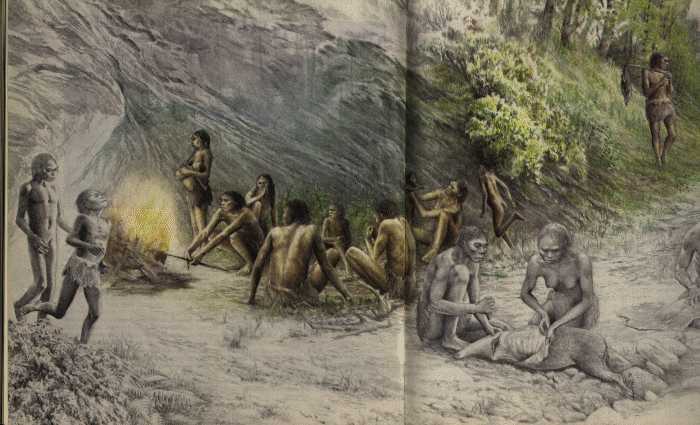
A community of Homo
erectus (Richard Leakey, Roger Lewin)
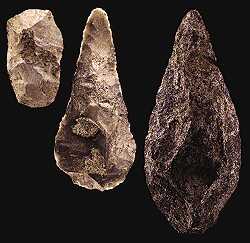
Tools used during the
Acheulean culture
Homo sapiens
Homo antecessor
and Homo heidelbergensis
It’s probable that the primitive Homo sapiens (Homo antecessor) evolved
about 1 million years ago from Homo ergaster. There are also traces that, following
his preys, he entered in Europe little after his appearance.
They were probably replaced, about 700 000 years ago, by the Homo
sapiens heidelbergensis. Their brain volume evolved to the dimensions of the
modern human brains, their jaws and skeletons became less robust and, as the
Homo erectus, they would have practiced the cannibalism and manufactured tools
that were typical of the Acheulean culture.
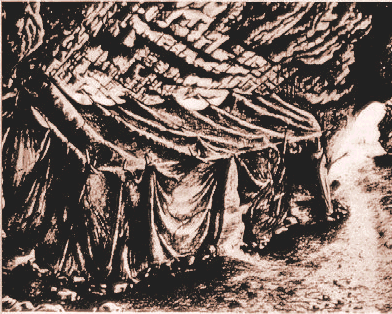
Hut dated from more than
400 000 years ago. It’s linked to the Acheulean culture, but it’s thought that
it could have been inhabited by Neanderthals
The Neanderthals
One of the descendants of this sub-species, the Homo sapiens
neanderthalensis (or the Neanderthals), which may have arisen 300 000 years ago
or more, had a cranial capacity higher than the actual humans’, but it is
thought that their brains were organized in a different way. They were the
first humans to live under the harsh conditions of the glaciations, which may
have determined the evolution of their physiognomy, particularly the prominent
foreheads and noses.
The Neanderthals would have reached a much more complex culture, inside
which the weakest and sick elements would have the support of their mates. The
deads were buried together with tools and food, which indicates the practice of
funerary rituals and the existence of religious beliefs. They possessed a form
of spoken language, although their physiognomy didn’t allow them yet the
production of a sounds’ set as broad as the modern human’s physiology does.
They had knowledge about the medicinal plants and they created the Mousterian
culture on tools’ manufacture, which appeared for the first time about 200 000
years ago. These tools were manufactured in several phases, so that bigger and,
sometimes, dented (saws) cutting surfaces were carved. Among the tools that
were produced, they included axes, knives, scrapers and the tips used in
spears. They were used to prepare skins, to cut the meat, to hunt, to saw wood,
etc. There are signs that they proceeded to the periodic maintenance of the
tools, which suggests that the tools were used during long time periods. They
built huts of wood, stone and animal skins, with central fireplaces. The
Neanderthals were also the first artists, in spite of being accused of
non-imaginative people: they made musical instruments (as flutes made out of
bones) and other artifacts with symbolic meanings.
About 28 000 years ago, the Neanderthals disappeared, but is not well
known why that happened. It’s possible that the Homo sapiens sapiens (a
sub-species relative to the Neanderthals, to which we all belong), which
presumably migrated from Africa, had in some way interbred with the
Neanderthals during the long period when they co-existed in the same regions.
This hypothesis is favoured by the discovery of what seems to be the skeleton
of a 24 000-year old hybrid child in a rock-shelter site called Lagar Velho, in
Portugal. It’s also quite possible that the competition exerted by the Homo
sapiens sapiens (which, compared to the Neanderthals, held competitive
advantages at diverse levels, namely the more developed imaginative capability
– the Neanderthals spent terribly long periods of time using the same techniques,
contrarily to the modern humans), along with the glaciation that was
intensified during that time, had driven this human sub-species to the
extinction (the last Neanderthal fossils were found in Gibraltar, at the very
end of Europe).
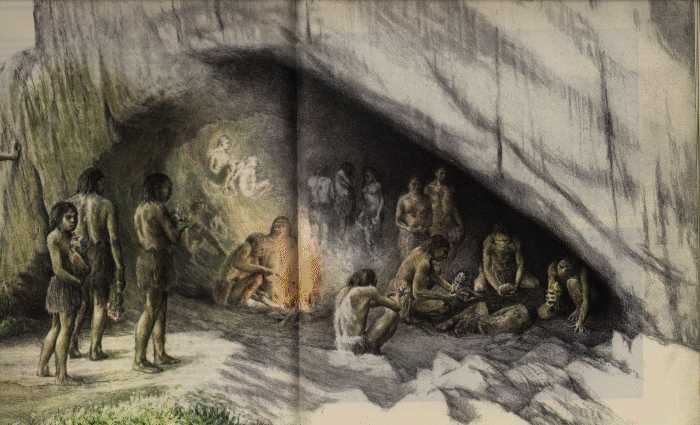
Neanderthals: the burial
of the man of Shanidar (Richard Leakey, Roger Lewin)

Tools from the Mousterian
culture
Homo sapiens sapiens
The most ancient known fossil of the Homo sapiens sapiens dates from 130
000 years ago. Until recently it was considered a species native of Africa, but
today it’s thought that it could have evolved simultaneously in Asia or could
be the result of migrations from Africa that occurred much earlier than 100 000
years ago, as it was traditionally thought. Those hypotheses could, for
instance, explain why some Australian fossils date from 60 000 years ago (20
000 years more than it would be expected if it was a sub-species that had come
out of Africa in a single migration 100 000 years ago). The Homo sapiens
sapiens is linked to the culture of the Superior Paleolithic, dominant between
40 000 and 12 000 thousand years ago. It was a culture that was originated
independently in Asia and (90 000 years ago) in Africa. The appearance of this
culture represented an increase in the complexity of the tools’ manufacture
techniques. The clothes (sewed with needles), the dwellings (whose construction
included the clay and/or mammoth bones and skins), the adornments, the
medicine, the nutrition and the ritual practiced were very refined during this
epoch. New forms of art emerged (sculpture – like the figures linked to
fertility – and painting – scenes recreated at the walls of the caves that were
cult places), different regional cultures began to become distinct and the
earliest hierarchies and social and labour divisions appeared, resulting from
the new industries associated to this culture.
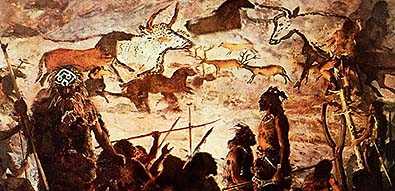
Religious cult in the
cave of Lascaux (Washington State University)
The Dawn
of Civilization
Neolithic
About 12 000 years ago, at the beginning of the Neolithic, a new
cultural revolution started to come, when the traditional style of life
consisting in hunting and recollecting was replaced by the agriculture, cattle
domestication and sedentarization of the populations in villages formed by
houses built with bricks (replacing the previously prevailing nomadism).
The agricultural excesses that started to accumulate led to the
construction of warehouses useful in shortage periods, to the appearance of
trade (where the excesses were exchanged by other products, agricultural or
not) and released work force to constitute armies, build temples and
fortifications, etc. At last, they paved the way for the foundation of new
social classes like the metallurgists (when the metal fusion was discovered,
8000 years ago) and other artisans, civil clerks, warriors, clergymen and
rulers.

Neolithic scene (Conhecer
Universal, Editora Abril S.A.)
At the end of the Neolithic big stone monuments (megaliths) were lifted
in several places of Europe and they are thought to have had funerary and
religious meanings (the religion was still very linked to the natural elements,
particularly the astronomical objects).
Historic Epoch
About 5000 years ago finally started to appear (in Mesopotamia (now
Iraq) and, later, in Egypt, India and China) the earliest large towns and it
was invented the writing, which allowed the humans to accumulate an
unprecedented quantity of knowledge. There emerged theocratic states (ruled by
semi-gods and clergymen), the first legal codes, the first literary works and
artistic objects made of precious metals.
From then on, the arts, the sciences and techniques, the philosophy and
the spirituality tended to improve quickly across the successive civilizations.
In the case of Europe the graeco-roman civilization was followed by the middle
ages (more advanced than the previous one in some aspects but less advanced in
others) and the renaissance. The evolution accelerated when about 400 years ago
Galileo defended that the Earth orbited around the Sun (beginning a scientific
revolution that lasts until today), when about 250 years ago the textile
industry was mechanized by the first industrial revolution and when about 200
years ago new ideas about the structure of the society started to be endorsed
by the American independence (1776) and the French revolution (1789).

Photography taken in
Varanasi (sacred Indian city) in 1865 (Library of Congress, Washington D.C.)
Today, so few decades later, the humans dominate the physics of the
atom, build increasingly powerful computers, prevent and cure illnesses that
were lethal just a few centuries ago, explore the extraterrestrial space, study
their own nature through sciences like genetics or neurology, create democratic
states and international cooperation organizations and continuously found new
cultural and social movements. What the future reserves for us will
depend on our capability for using the technology in the benefit of the living beings
that inhabit this planet or, contrarily, to use it with self-destruction
purposes.
_